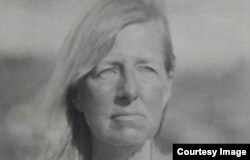During the American Civil War, a number of soldiers had their portraits taken on the battlefield. The images, recorded on glass negatives called wet plates, provide an enduring record of the men who fought in the war between the northern Union and southern Confederate states. Since each wet plate needed a 5- to 20-second exposure, there are no action photos of the war.
Today, reenactments on the battlefields keep Civil War history alive. They date back to the time when veterans of the war recreated battles to remember their fallen comrades and to teach people about what happened.
John Milleker, a Baltimore, Maryland photographer, travels to Civil War sites to take photos of reenactors, who really get into their role-playing. So does Milleker, who set up a tent on the Antietam battlefield in Sharpsburg, Maryland, during a recent reenactment. His tent is similar to what Civil War photographers would have had in the field to develop images.
Dressed in a white shirt, red vest and black jacket, his clothing was reminiscent of the era.
Geoff White portrayed General George McClellan, who led Union troops at Antietam in the war's bloodiest one-day battle. White, who resembles the general, primped for his portrait, taken with a 100-year-old camera and a lens that "might have even been used in the Civil War," said Milleker.
White put his head up against a brace that helped him remain motionless while the photo was taken.
"That's actually a direct cast of the brace that was used during the Civil War," said Milleker. "Even today, even with the head brace, sometimes people can’t sit still or stand still for many seconds at a time."
Milleker looked through the camera at an upside down image, put a wet plate into a sun-proof holder and slid it into the back of the camera. The glass was covered with silver nitrate, a photographic material that darkens the image.
As was characteristic in Civil War portraits, McClellan didn’t smile.
"It just wasn’t proper to smile in a photograph," Milleker explained. "And the thought of that came from, maybe people’s teeth weren't as good."
After taking the photo, Milleker hurried to the tent to take the plate to a portable darkroom, a "dark box," for developing. He had to do this before chemicals on the plate dried. "The problem is they are very susceptible to cold, heat, humidity, breeze," he said.
He uses the same chemical process as Civil War photographer Matthew Brady did. It includes cyanide, which makes the image emerge from the plate.
"Cyanide is one of the most dangerous chemicals known to man," Milleker said. "We use it in such a small percentage. It makes the plate have a sepia tone to it."
Earlier, Milleker had taken another photo mimicking a real Civil War image of President Abraham Lincoln meeting with McClellan after the Battle of Antietam. To White, the experience almost seemed real as he interacted with another reenactor.
"When I took the photo with Abraham Lincoln, there was this moment of extreme tension where we were sizing each other up, and I felt like I was George McClellan being stared down by his boss," he said.
Wet-plate photography was immensely popular during the Civil War. Milleker, mostly a modern-day digital photographer, said he likes "having one foot back in the 19th century."










